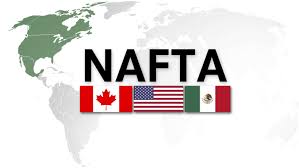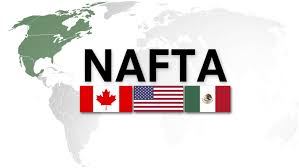
Aiming to shrink a growing trade deficit with Mexico and tighten the rules of origin for cars and parts, the Trump administration is starting renegotiations of the 23-year-old NAFTA trade pact this week but has set a collision course with the auto industry.
U.S. President Donald Trump blames the North American Free Trade Agreement, which he blames for taking car factories and jobs away from America to low-wage Mexico and autos have been the focus of Trump's anger over NAFTA agreement, more than any other industry.
According to U.S. Census Bureau data, the dominant component of an overall $64 billion U.S. deficit was the autos and auto parts as the United States had a $74 billion trade deficit with Mexico in autos and auto parts last year.
"The Trump administration has framed their NAFTA negotiating objectives around reducing the trade deficit with Mexico," said Caroline Freund, a senior trade fellow at the Peterson Institute for International Economics. "If they don't touch autos, there's no way of getting at what they want."
Strengthening the rules of origin to shut out more parts from Asia, and possibly an unprecedented U.S.-specific content requirement for Mexican vehicles are among tools that U.S. Trade Representative Robert Lighthizer may seek to boost auto employment in the U.S.
Concerns among auto industry executives and trade groups have been raised who believe that Lighthizer will seek a deal that guarantees a certain percentage of production for the United States even as his negotiating objectives for NAFTA seek to "ensure the rules of origin incentivize the sourcing of goods and materials from the United States and North America".
Already the highest of any global trade bloc is carve-out or to increasing the percentage of a vehicle's value that must come from the region above the current 62.5 percent and the industry is opposed to such measure.
North American car production has bene made competitive with Asia and Europe by this and doing anything contrary would raise costs and disrupt a complex supply chain that sees parts crisscrossing NAFTA borders.
"Our members feel very strongly that rules of origin are not the tools to use to reshore jobs into the U.S.," said Ann Wilson, senior vice president of government affairs for the Motor and Equipment Manufacturers Association, a trade group representing auto parts makers.
A better way to boost U.S. manufacturing jobs is through policies aimed at expanding vehicle exports, say Wilson and other industry advocates.
Since the "tracing list" of parts that count towards that goal would be modernized, it would be harder to reach the 62.5 percent content threshold if U.S. Commerce Secretary Wilbur Ross gets his way. The current rules allow a tariff-free "back door" for Chinese auto parts and are too loose, he argues.
Charles Uthus, vice president for international policy at the American Automotive Policy Council, a lobbying group for Ford Motor Co., General Motors and Fiat Chrysler said that automakers will simply skip compliance "and they'll just end up paying the duty" if the content requirements become too onerous.
(Source:www.reuetrs.com)
U.S. President Donald Trump blames the North American Free Trade Agreement, which he blames for taking car factories and jobs away from America to low-wage Mexico and autos have been the focus of Trump's anger over NAFTA agreement, more than any other industry.
According to U.S. Census Bureau data, the dominant component of an overall $64 billion U.S. deficit was the autos and auto parts as the United States had a $74 billion trade deficit with Mexico in autos and auto parts last year.
"The Trump administration has framed their NAFTA negotiating objectives around reducing the trade deficit with Mexico," said Caroline Freund, a senior trade fellow at the Peterson Institute for International Economics. "If they don't touch autos, there's no way of getting at what they want."
Strengthening the rules of origin to shut out more parts from Asia, and possibly an unprecedented U.S.-specific content requirement for Mexican vehicles are among tools that U.S. Trade Representative Robert Lighthizer may seek to boost auto employment in the U.S.
Concerns among auto industry executives and trade groups have been raised who believe that Lighthizer will seek a deal that guarantees a certain percentage of production for the United States even as his negotiating objectives for NAFTA seek to "ensure the rules of origin incentivize the sourcing of goods and materials from the United States and North America".
Already the highest of any global trade bloc is carve-out or to increasing the percentage of a vehicle's value that must come from the region above the current 62.5 percent and the industry is opposed to such measure.
North American car production has bene made competitive with Asia and Europe by this and doing anything contrary would raise costs and disrupt a complex supply chain that sees parts crisscrossing NAFTA borders.
"Our members feel very strongly that rules of origin are not the tools to use to reshore jobs into the U.S.," said Ann Wilson, senior vice president of government affairs for the Motor and Equipment Manufacturers Association, a trade group representing auto parts makers.
A better way to boost U.S. manufacturing jobs is through policies aimed at expanding vehicle exports, say Wilson and other industry advocates.
Since the "tracing list" of parts that count towards that goal would be modernized, it would be harder to reach the 62.5 percent content threshold if U.S. Commerce Secretary Wilbur Ross gets his way. The current rules allow a tariff-free "back door" for Chinese auto parts and are too loose, he argues.
Charles Uthus, vice president for international policy at the American Automotive Policy Council, a lobbying group for Ford Motor Co., General Motors and Fiat Chrysler said that automakers will simply skip compliance "and they'll just end up paying the duty" if the content requirements become too onerous.
(Source:www.reuetrs.com)





